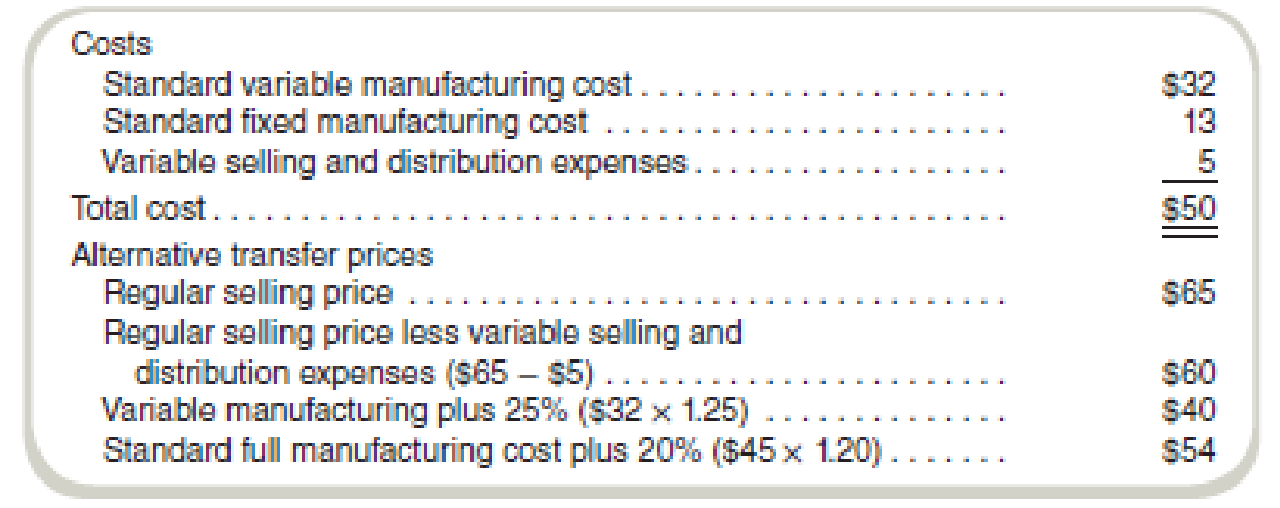
Western States Supply, Inc. (WSS), consists of three divisions—California, Northwest, and Southwest—that operate as if they were independent companies. Each division has its own sales force and production facilities. Each division manager is responsible for sales, cost of operations, acquisition and financing of divisional assets, and
Southwest has just been awarded a contract for a product that uses a component manufactured by outside suppliers as well as by Northwest, which is operating well below capacity. Southwest used a cost figure of $37 for the component in preparing its bid for the new product. Northwest supplied this cost figure in response to Southwest’s request for the
Northwest’s regular selling price for the component that Southwest needs is $65. Northwest’s management indicated that it could supply Southwest the required quantities of the component at the regular selling price less variable selling and distribution expenses. Southwest management responded by offering to pay standard variable manufacturing cost plus 25 percent.
The two divisions have been unable to agree on a transfer price. Corporate management has never established a transfer price policy. The corporate controller suggested a price equal to the standard full manufacturing cost (that is, no selling and distribution expenses) plus a 20 percent markup. The two division managers rejected this price because each considered it grossly unfair.
The unit cost structure for the Northwest component and the suggested prices follow

Required
- a. Discuss the effect that each of the proposed prices could have on the attitude of Northwest’s management toward intracompany business.
- b. Is the negotiation of a price between Northwest and Southwest a satisfactory method to solve the transfer price problem? Explain your answer.
- c. Should WSS’s corporate management become involved in this transfer price controversy? Explain your answer.
Want to see the full answer?
Check out a sample textbook solution
Chapter 15 Solutions
FUND.OF COST ACCT >CUSTOM<
- I need the correct answer to this general accounting problem using the standard accounting approach.arrow_forwardCan you help me solve this general accounting question using valid accounting techniques?arrow_forwardI need guidance with this general accounting problem using the right accounting principles.arrow_forward
 Managerial AccountingAccountingISBN:9781337912020Author:Carl Warren, Ph.d. Cma William B. TaylerPublisher:South-Western College Pub
Managerial AccountingAccountingISBN:9781337912020Author:Carl Warren, Ph.d. Cma William B. TaylerPublisher:South-Western College Pub Cornerstones of Cost Management (Cornerstones Ser...AccountingISBN:9781305970663Author:Don R. Hansen, Maryanne M. MowenPublisher:Cengage Learning
Cornerstones of Cost Management (Cornerstones Ser...AccountingISBN:9781305970663Author:Don R. Hansen, Maryanne M. MowenPublisher:Cengage Learning Financial And Managerial AccountingAccountingISBN:9781337902663Author:WARREN, Carl S.Publisher:Cengage Learning,
Financial And Managerial AccountingAccountingISBN:9781337902663Author:WARREN, Carl S.Publisher:Cengage Learning,- Principles of Accounting Volume 2AccountingISBN:9781947172609Author:OpenStaxPublisher:OpenStax College
 Accounting Information SystemsAccountingISBN:9781337619202Author:Hall, James A.Publisher:Cengage Learning,
Accounting Information SystemsAccountingISBN:9781337619202Author:Hall, James A.Publisher:Cengage Learning,




